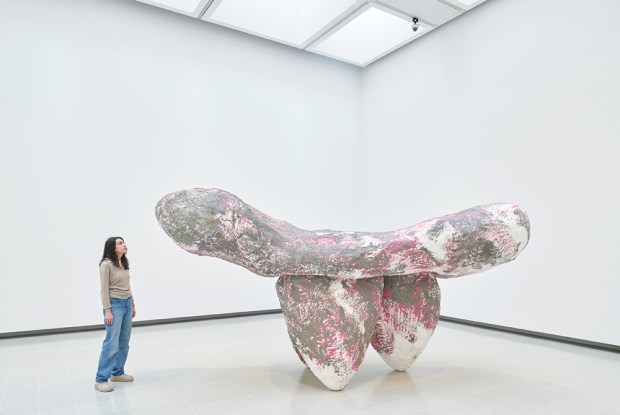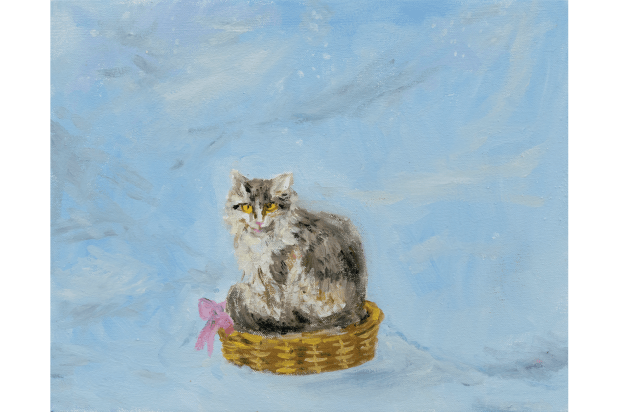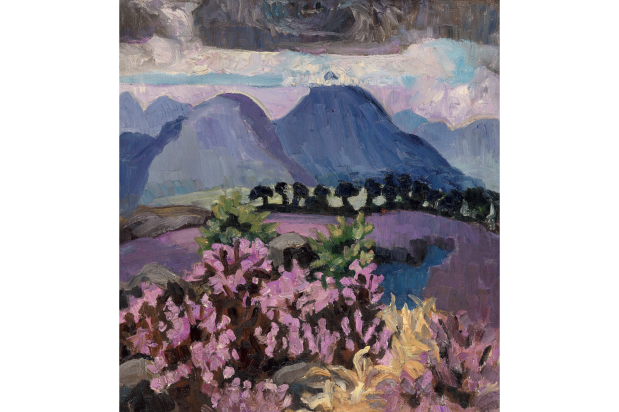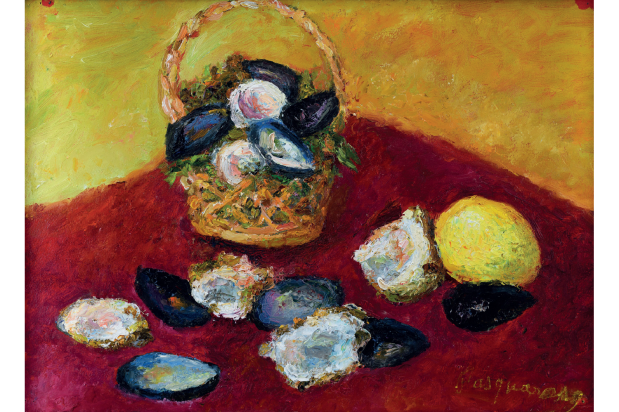ENO’s Mask of Orpheus is a triumph. It’s also unintelligible. Even David Pountney, who produced the original ENO staging in 1986, admitted to me in the interval that he didn’t have a clue what Harrison Birtwistle’s opera was about. But who cares when, visually and musically, you’re being socked between the eyes? Mask makes sense in the same way an earthquake makes sense.
Fittingly we begin with total nonsense: Orpheus, in the bath, attempting to reform language. This is Orpheus the Man, in red velour and gelled-up hair, looking like Rod Stewart. An unlikely charmer of fishes and trees, it has to be said. But soon enough another Orpheus pops up: Orpheus the Myth, looking even worse, like Rod Stewart’s drunk dad. This one can barely charm his own wife, let alone the fishes or trees.
The third Orpheus we see, ripped and tattooed, is Orpheus the Hero. ‘Hubba hubba’, you can almost hear the fishes and trees murmur. This deliberate sandwiching of different versions of the myth by Birtwistle and his librettist Peter Zinovieff should confuse. It doesn’t — not immediately. Indigestion comes only as the story acquires more and more fillings — including every one of the four variants on Orpheus’s death. Yet with every retreat from narrative sense comes more room for the visual and musical.
Some will claim the result is oversaturation in all the corde lisse, mime, dance, frantic projections, the sinister battalions of rubber Hattie Jacqueses and pink Benjamin Franklins. Possibly. But it’s hard not to be awed at the costume creations of Daniel Lismore. The gasps were audible in the third act with the arrival of the fuchsia pink Teletubbies — heads shaped like blocks, cones, globes and parcels — who bounced and jiggled across the stage. A nod to Bauhaus’s Oskar Schlemmer. A nod to the Mr Men. A joyous high-low extravaganza. The postwar browns, greys and blacks of Birtwistle’s flinty musical canvases are thrilling. But I was happy to have a side order of Day-Glo surrealism.
Thomas Beecham famously claimed he’d once trod in some Stockhausen. I feel the same about Birtwistle. His music is music you walk on. He composes the ground beneath you. His compositions never face you, they rumble up through your feet, and occasionally, when a gust of wind whips up a cloud of their dry topsoil, they temporarily blind or choke. It’s the music of scrubland, sand and chalk.
A full orchestral eruption is withheld until the arrival of the Oracle of the Dead, the extraordinary Claron McFadden in mitre and beetley dress. And when this happens it’s like a geological event, a slippage in the crust. In the second act a tornado sweeps through the percussion. Critics go on about the music’s complexity. But it is as elemental as it is complex.
Jonathan Cross claims in the booklet that Mask ‘challenged what an opera could be or do’. Pah! Maybe in Britain. In America Robert Ashley and Meredith Monk had gone far further far earlier. For a real rebuke to opera, head to Tate Modern. In 1969, the Korean-American artist and Fluxus composer Nam June Paik created ‘Electronic Opera #1’ for TV, in which a rainbow Mobius strip dissolves Richard Nixon’s face to the sounds of Clockwork Orange-y synths.
Paik’s whole career was a series of detonations. In ‘One for Solo Violin’ (1962), he destroys — quite spectacularly — a violin. In ‘Variations on a Theme by Saint-Saëns’ (1964), a cellist dunks herself in an oil drum full of water midway through a performance of ‘The Swan’. In ‘Listening to Music Through the Mouth’ (1962–3) Paik attached a stylus to the end of a dildo which he shoved in his mouth and used to play a record. Childish one-liners, some will say. But imagine performing these in a Wigmore Hall recital? Semtex is packed into these gags — with real consequences for sound, how to listen, why we perform the way we perform.
He never stopped exploding the possibilities of his medium. His famous TV walls are like glorious vertical ballets: a fizzy, melty, snowy parade of sweetshop colour, rhythm and line. And oh what a beautiful thing the cathode-ray tube TV was. The apogee of pointillism. (When is someone going to do a Paik and Seurat show?) The most fallible and alive of our technological friends.
Paik’s experiments could even move. I choked up as I watched his requiem for the Fluxus founder, ‘In Memoriam George Maciunas’ (1978), Joseph Beuys leaping transcendently up a piano in Brucknerian splashes, while Paik hugged a ticking clock, muffling it with a drape. Fluxus was a fractious group. But they only really had each other.
This terrific show climaxes with something of absolute wonder. Paik’s ‘Sistine Chapel’ (1993) transforms a room into a flickering, flashing supernova, a whirl of colour, dance and sound and a dozen hot but happy projectors.
The postmodernism of artists like Birtwistle and Paik is often seen as being a cold little joke. In fact the work of these two greats is as all-embracing, visceral and humane as art has ever been.
Got something to add? Join the discussion and comment below.
Get 10 issues for just $10
Subscribe to The Spectator Australia today for the next 10 magazine issues, plus full online access, for just $10.
You might disagree with half of it, but you’ll enjoy reading all of it. Try your first month for free, then just $2 a week for the remainder of your first year.


![English National Opera's triumphant new production of Harrison Birtwistle's The Mask of Orpheus, directed by Daniel Kramer. [Photo: Alistair Muir]](https://www.spectator.com.au/wp-content/uploads/2019/10/Opera_Exhibitions.jpg?w=730&h=486&crop=1)












Comments
Don't miss out
Join the conversation with other Spectator Australia readers. Subscribe to leave a comment.
SUBSCRIBEAlready a subscriber? Log in